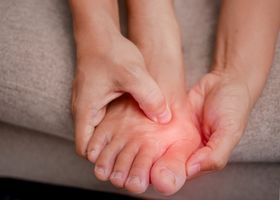Insertional Achilles Tendonitis: Causes, Symptoms, and Treatment
Published August 1, 2022

Insertional Achilles tendonitis, a type of Achilles tendonitis, refers to inflammation at the point where the Achilles tendon attaches to the heel bone. The fibers of the tendon become inflamed, leading to Achilles tendon pain and reduced mobility in severe cases.
Achilles tendonitis left untreated over a lengthy period can lead to chronic Achilles tendonitis and persistent pain. Insertional Achilles tendonitis requires suitable treatment, as it doesn't go away by itself.
Insertional Achilles Tendonitis vs. Non-Insertional Achilles Tendonitis
There are two types of Achilles tendonitis:
- Insertional Achilles tendonitis As the name suggests, this type of tendonitis occurs at the insertion point of the Achilles tendon with the heel bone. In some cases, the heel bone may protrude outwards.
- Non-insertional Achilles tendonitis This affects the middle fibers of the Achilles tendon and is commonly seen in younger people who are physically active.
Causes of Insertional Achilles Tendonitis
Overusing the tendon through various activities is the leading cause of insertional Achilles tendonitis. This condition is common in those that are not physically active.
Heel spurs (bony projections into the soft tissue around the heel) are also a common cause of developing Achilles tendonitis. Discomfort arises when the bony projection grows to a point where agitation of the soft tissue occurs.
Additionally, heel bursitis commonly occurs alongside insertional Achilles tendonitis.
Symptoms of Insertional Achilles Tendonitis
The symptoms of insertional tendonitis are directly linked to the amount of repetitive stress placed on the tendon and include:
- Pain at the base of the Achilles tendon, with sensitivity to touch
- Swelling at the attachment site
- Stiffness in the ankle or feeling in the tendon
- Development of a prominent heel bone in some cases
- Pain when stretching the Achilles tendon
Continued exercise without activity modification will exacerbate your symptoms.
Treating Insertional Achilles Tendonitis
Prevention of Achilles tendonitis is always better than treatment; however, it is not always possible. That being said, treatment of insertional Achilles tendonitis is usually conservative in mild cases of the condition, while surgery is considered in severe cases. A complete rupture of the Achilles tendon will definitely require surgery.
Non-surgical management strategies are preferred in most cases, including:
Rest
Take some time to rest from exercises or activities that may cause flare-ups. If pain is worsened by exercise, stop the activity immediately and allow time for the tendon fibers to repair themselves.
Only resume physical activity when pain has subsided entirely for about six weeks or under the advice of a medical professional. Then, gradually increase activity and limit the duration and intensity until you are fully accustomed. Failing to do this may cause another flare-up of Achilles tendonitis, which will be even worse the second time.
Medication
Anti-inflammatory medication can be extremely helpful in managing the symptoms of those conditions in the acute phase.
Ice
Applying ice to the area is important in reducing inflammation in the tendon and lessening your pain and swelling. Ice can be applied for 15–20 minutes at a time, several times a day, and is usually recommended in the acute phase for the first two days.
Orthotics
An orthotic with a slight heel raise can be beneficial in reducing the tension placed on the tendon while on your feet. Orthotics for Achilles tendonitis help alleviate your symptoms, prevent ongoing pain, and limit complications arising in the future.
How long you have to wear orthotics will depend on your individual condition; however, it is usually a long-term treatment.
Stretching
Gently stretch the length of the leg from the calf muscle to the Achilles tendon, allowing the collagen fibers to heal in correct alignment. Stretching can be done on a step, in various yoga poses, or against a wall. Hold the stretch for 20–30 seconds to allow the tissue to lengthen, provided there is no heel pain when stretching.
Physical Therapy
A physical therapist can provide you with a treatment strategy to target this condition, using various treatment modalities and exercise therapy for your Achilles tendon. Your physical therapist can advise you on whether it is safe to return to sporting or exercise activities without the risk of worsening the condition.
Does Insertional Achilles Tendonitis Heal Permanently?
In mild forms of the condition, rest in combination with conservative treatments can alleviate symptoms of this condition entirely. Severe cases may become chronic and lead to the lengthy, ongoing presence of symptoms that might require more drastic treatment methods.
Even with the correct treatment, recovery from insertional Achilles tendonitis is a very slow process, taking six months to a year to heal fully. Once the Achilles tendon has been injured, there is a greater likelihood of developing further tendon injuries in the future, so you should take precautionary measures.








